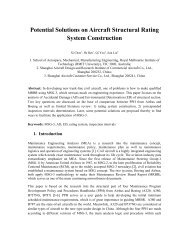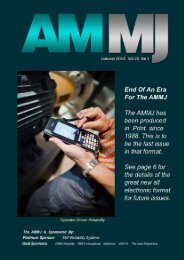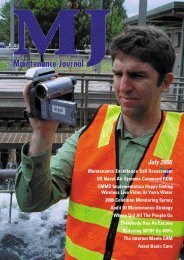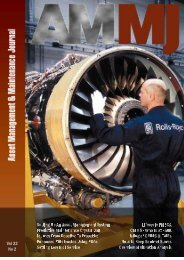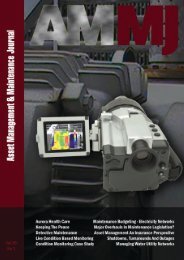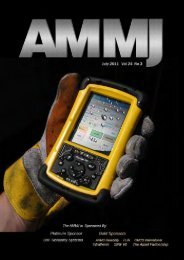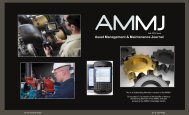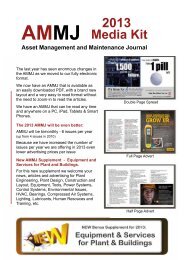Predictive Maintenance Planning With Fuzzy Neural ... - AMMJ
Predictive Maintenance Planning With Fuzzy Neural ... - AMMJ
Predictive Maintenance Planning With Fuzzy Neural ... - AMMJ
- No tags were found...
You also want an ePaper? Increase the reach of your titles
YUMPU automatically turns print PDFs into web optimized ePapers that Google loves.
<strong>Predictive</strong> <strong>Maintenance</strong> <strong>Planning</strong> <strong>With</strong> <strong>Fuzzy</strong> <strong>Neural</strong> Networks andMulti Criteria Decision Making Method in Parts ManufacturerPouyeh Rezazadeh<strong>Maintenance</strong> Manager, Mehr Industry Group, 85287, Tehran, Iraninfo.Zadeh@Gmail.ComAbstract: with the advent of predictive maintenance in 1980, dramatic changes occurred in equipmentplanning perspective. Given that predictive maintenance, based on predictive failure on equipment inuse, it can be previewed more truly predict of the occurrence of failures in the future. As ifmaintenance costs can be significantly reduced; this approach requires the use of multiple tools andtechniques. Such as techniques are utilizing in artificial intelligence, neural networks and fuzzy settheory. Parts manufacturer of the vehicles (original manufacturer service providers) in Iran have thesignificant maintenance costs among the industries. Therefore, the use of predictive maintenance iseconomically justified. Molding industry is preferred because production process and the use of suchmold due to heavy use, depreciation is incurred numerously. This makes development expenses forparts manufacturer. In this study, predictive failure model based on combined fuzzy neural network andmulti criteria decision making was performed. The results show that the proposed model reduceinspection costs 42% compared to the current situation.Keywords: Preventive <strong>Maintenance</strong>; <strong>Fuzzy</strong> <strong>Neural</strong> Network; Multi Criteria Decision Making; Mold<strong>Maintenance</strong>1. IntroductionIn accordance to important role of <strong>Maintenance</strong> processes in System reliability and Continuity ofservice providing, it’s Necessary utilizing new techniques to achieve maintenance targets. Although theplace of origin, Systems of Nets are in the United States, but the proposed new approach andphilosophy about PMs Formed in Japan. Machine failure occurs when a component Structure of thesystem can be programmed to Satisfy <strong>Maintenance</strong> strategies includes unplanned and planned activitiesand make the whole system is being acceptable.Some researchers have used neural networks in Failure detection problems. Hey et al. have studiedmulti layer feed forward network based on the study of Machine condition recognition method. Certainfuzzy relations between symptoms of failure and high non-linear relations were presented betweeninputs and outputs. [ 8]Knappand and Wang surveyed the Application of <strong>Neural</strong> Networks to recognize the Failurepropagation, by Using fluctuated data from the of CNC machine. Becraft and Lee developed anArtificial intelligence system that has been investigated as a tool for Fault diagnosis in chemicalprocess plants with high dimensions. [ 14].Knapp et al. used preventive maintenance schedules, within Prevention through an integratedmaintaining and have made improving data approach meaningfully with all employees and beingcreated opportunities in performing preventive maintenance planning .Most importantly, the systemallows expert to be updated, so that preventive tasks, alternation, communication effectiveness and costcan be constantly reviewed. The preventive maintenance programs, applies particularly in developingmore shortcomings, as an alternative to preventive approach. [ 14]In the 1980s, executive affairs based on the overall condition of the equipment, was replaced bypreventive maintenance. <strong>Predictive</strong> <strong>Maintenance</strong> Due to the use of new methods Evaluate the technical
condition of equipment and their status in Which are under operation with signs of wear and possibleimpending failures, so that will be revealed TPM plays an important role in <strong>Predictive</strong> maintenance,involving collecting and interpreting online data on the production and operation of the majorcomponents of equipment. This will be more obvious in Failure prediction, and determination of PMappropriation in repair strategy. [ 4]Development of TPM initiated in1970, <strong>With</strong> the continuous expansion of knowledge and Continuoustechnical state of equipment TPM approach usually is known in the production parts and in this contextis known to be applied in medium and high volume This is probably due to implementation of TPMwhich In areas of high volume production is remarkable, and beneficially, so important for theinstitution. However, in contrast TPM Should not to be limited in high volume areas and to averagevolume, The approach should not be Only considered as to be used for machines manufacturing in theworkshop.It is the philosophy should be spread throughout the company's operational activities,Increasing the awareness and understanding of all people at all levels of the organization.In recent years, artificial neural networks have been used successfully in pattern recognition tasks andfault detection problems. One of the main advantages of using artificial neural networks is the ability todetect patterns that are inaccurate. This research seeks to implement the fuzzy neural network inpredictive maintenance in fault patterns.NEP et al. provided a real-time neural network position control system based on workflow ofMechanical equipment. In this study, another type of neural network Called ARTMAP Developed in1992 by a Carpenter and his colleagues used. In such a way, network training, is a combination ofsupervised Training and unsupervised learning. Also in this model, new information about the status ofthe machine is controlled by continuously oscillating Data. Javadpour and Knapp worked on <strong>Fuzzy</strong>neural networks approach in condition monitoring of machinery and inputs, they used thecharacteristics of fuzzy sets and the membership values for classification between zero and one. [ 13]In addition, In application of system maintenance by Jones and, Evans, Bansal the neural networkapproach is applied [ 4]. Bansal et al. used a <strong>Predictive</strong> real-time plant-based production, accompaniedwith learning characteristic of neural network mappings for non-Liner to allow recognition of machineparameters. By this the cost of the data parameter measuring was reduced. In their investigation, threegroups of training data, Data validation and test data models, were classified. Then data had beennormalized .To summarize the data, Principal Component Analysis (PCA) has being Used in theirwork, dimensions of Data Has decreased from 400 to 14. They utilized a multi-layer perceptionnetwork with combined optimization, in a graded trained soft-max activation function (ScaledConjugate Gradient-(SCG)).Mrossi, Mazzieri and Lucifredi identified the best technique for control systems, as two methods:multiple linear regression analysis and a developed technique called dynamic kriging were comparedwhile neural networks were being used in. The results of this research show inefficiency of statisticalmethods in arriving to an optimal solution. The combinations of these methods with neural networkhave been effective in optimal maintenance prediction time. [ 16]The mentioned network had 15 neurons in the first layer and combined of the 10 neurons for thesecond layer. Molina et al. combined neural network with expert system joined with preventivemaintenance (NNMP -<strong>Neural</strong> Network <strong>Maintenance</strong> <strong>Predictive</strong>). [ 18].They suggested a neural network approach as a very suitable one to have a predictive control system.The reason was on non-linear relationship between the data and the abnormal condition. In contrast, theexpert systems try to imitate operator response and analyze the same variables like humans. <strong>Neural</strong>Networks overcome the limitations and try linear regression analysis relations between the differentmarkings. In this study identification of ARTMAP has used different situation architecture in order toprevent unfavorable conditions in the future. [ 18]
In another trial, Bansal et al have devised an inversion algorithm to confirm current movements forestimating the parameters of the system. It was in a predictive maintenance system called Bjest. Thisalgorithm was based on neural networks, used the function mapping nonlinear control systems fortraining. Therefore, the quality of network depends on Data Performance in network training. [ 3]In recent years, creating a Combination model of fuzzy logic and neural networks for betterperformance basically, have made many attempts in the decision system. Developing literature onjoining <strong>Fuzzy</strong> system and neural networks together to expand the systems, in many papers oftenincludes the following: [ 11]-Using neural networks for adaption in <strong>Fuzzy</strong> systems;- The combination of fuzzy systems and neural networks that are called: "Hybrid Systems";- The application of neural networks to estimate <strong>Fuzzy</strong> <strong>Neural</strong> Network;<strong>Neural</strong> networks are simple computational tool for testing data and the model data structure. Data areused to create models known as the training data. While a neural network uses training data forlearning patterns in the data, they can achieve the outputs and different outcomes. Different types ofneural networks synthesized and according to the research objectives can be used, as one of the mostfamous is multilayered feed forward MFNN. [ 26]According to recent studies, multi-layer feed forward neural network has more than fifty percent ofapplied studies reported in <strong>Neural</strong> Network that have been utilized with laws of propagation learningalgorithm [ 3]. This type of neural network with wide applications in many aspects such as Managementprinciples, issues in prediction classification, and modeling. Solving problems that are considered“MFNN” involves learning the relations. A set of input and output are specified between. In fact, it is asupervised learning technique to learn about data relations among data set forms the trainings.Although artificial neural networks and fuzzy systems are different from each other in terms ofstructure, however, if they can be viewed by strengths and weaknesses, it is observed that the natures ofthe two systems are complementary to each other. Thus, the combination of fuzzy systems, artificialneural networks and learning capabilities of neural networks, will be entered into fuzzy systems.2. <strong>Fuzzy</strong> <strong>Neural</strong> NetworkLearning processes in fuzzy neural networks is the variation of parameters or coefficients of networkusing examples have already been experienced. This operation of the network parameters adaption isdone so that a defined index reaches a satisfying answer that the lowest or highest possible providingamount is fulfilled. This is required, having a set of ordered pairs of input and output, and also there isan indicator that expresses the mapping of inputs x k to the desired output values of t k .The structure of fuzzy neurons is like neurons in definite space, Except that all or some of thecomponents and parameters are expressed in terms of fuzzy logic. To convert a Conventional neuron tofuzzy neurons, there are several ways. Using each of them, result in a variety of fuzzy Neurons.In a fuzzy neuron Input vector X=⎣x1, x 2 ,..., x n⎦T ∈Rn is defined in [0,1]n space ,This vector isdefined, of fuzzy symptoms <strong>With</strong> a membership function in the range of (1, 0) .Inputs after makingchanges By coefficients, insert to the neuron as the pure inputs.The variation of coefficient by inputs may be different. This change can be ordinary multiplication orthe maximum related input rate. The concept of fuzzy neurons can be assumed that each neuron has afuzzy representation of a linguistic variable such as low, medium and so on. This means that the jthneuron output yj, reviews representing a membership function. Which shows the input vectormembership rate of ⎣ x1, x2,..., xn ⎦ r to linguistic categories belongs.
<strong>Fuzzy</strong> artificial networkEffective factor infaultinessAnalyticalnetworkprocessDatanormalizationExit ofnormal stateSuitable time forinspectionFigure 2: Proposed predictive maintenance systemProposed fault diagnosis methodology is comprised of three steps (Fig. 2). The first step is acquiringthe real-time process information from critical parts, such as Max. Machine injection pressure,Clamping force, Injection pressure, Water temp., hot manifold temp and screw diameter which are themost important process variables to be monitored and identified in ANP and have the capability ofrepresenting the state of operation in a variety of Tools. The fault in these variables can affect thestability and safety of the whole maintenance process system. The second step is making inferences(diagnosis) based on acquired process information. The last step is making actions according to theinference values, such as informing operators, raising alarms, shutting down equipment, activatinghigher layer protections, re-assembling and trying to bring the tools back to normal condition.3.2. Plastic injection mold preventive maintenanceMold maintenance basically consists of properly designed sprue, runner, gate, and cavity. The Sprue isthe channel, cut in the stationary plant that transports the melt from the plasticator nozzle to the runner.Once the plastic melt enters the mold, it flows through a distribution system, called the runner system,and then through the gates into the part cavities. In a so-called cold runner system, a new runner ismolded in each molding cycle and the runner is ejected together with the molded parts. The plastic ofthe runner can often be reprocessed and molded again Heat removal from the plastics materialcontained in the mold is, however, difficult as plastics material contains a lot of heat and has a lowthermal conductivity.Cooling allows the plastic to solidify and become dimensionally stable before ejection. Heat that hasbeen transferred to the mold by the molten plastic is carried away by a coolant that circulates throughcored passages in the mold. Coolant temperature and flow rate determine the efficiency of heat removaleach process variable can be categorized into one of five main types such as speed, pressure, time,temperature and stroke. The relationship between the five is of an interactive nature as each variablecannot be readily isolated. This relationship can be simply demonstrated, for example, upon increasingthe hydraulic back pressure, the linear retraction speed of the screw (during recovery) changes causingan increase in the screw recovery time, the melt temperature end/or homogeneity. As a result of theincrease in the melt temperature further changes occur to the mold fill time, the injection pressure, themold temperature, the product ejection temperature and the product dimensions. Hence, by increasing apressure variable (for example, the hydraulic back pressure) three other main variable types arecollectively influenced. More important, the process and subsequently the molded components areaffected.3.3. Practical Data in mold fault detectionThe following table highlights typical process variables which need to be monitored and/or controlledeach cycle. Each of the listed variables will be discussed in more detail to highlight the importance ofeach variable with respect to the stability of the maintenance process.Temperat.MeltMold SurfaceBarrelTable 1: All process variablesTimesSpeeds PressureEjectionInjectionHoldingMold closeScrewInjectionMold open Mold close Hyd. BackStrokesMelt CushionScrew strokeMold open
1113Not inspection1133Not inspection1148inspection1158inspection1167inspection1114Not inspection1134inspection1149inspection1158inspection1167inspection1115Not inspection1135Not inspection1149inspection1159inspection1168inspection1116Not inspection1136inspection1150inspection1159Not inspection1169inspection1117inspection1137Not inspection1150inspection1160Not inspection1170inspection1118Not inspection1151inspection1171Not inspection1119Not inspection1151Not inspection1172Not inspection5. ConclusionIn this study, we have designed a hybrid model analytic network process (ANP) and fuzzy neuralnetworks to control and predict Failure times. For this purpose, we studied 6 Factors influencing moldmanufacturing faults. Then, using the analytic network process, number of criteria was reduced from 6to 3 series. After calculating the period of disability the network analysis of the output of the networkwas considered as input variables of fuzzy neural networks. Using fuzzy neural networks, The resultswere compared with the case of fixed time frames based on 15-day, The results show that the fuzzyneural network prediction model, have Reduced inspection costs by 25% being compared to the sametime of inspection Therefore, using this model we can also avoid the drawbacks of sequential faultslead to Stop in providing the services, the risk of explosion, and the dangers of life, significantly reducethe costs of inspection.References[ 1] A. Borden, “Designing and Maintaining Decision-making Processes”. AGARD ConferenceProceedings, Paris, France, 1993[ 2] A. Hurson, S. Pakzad, B. Lin, “Automated Knowledge Acquisition in a <strong>Neural</strong> Network BasedDecision Support System for Incomplete Database System”. Microcomputers in CivilEngineering, Vol. 9, No. 2, 1994.[ 3] Bansal D. Evans D. Jones B, (2006) Bjest: A reverse algorithm for the real-time predictivemaintenance system, International journal of machine tools & Manufacture; (46) 1068-1078.[ 4] Bansal D. Evansb DJ. Jones B, (2005) Application of a real-time predictive maintenance system toa production machine system .J Machine tools and manufacture; 1210- 1221.[ 5] Becraft WR. Lee P L, (1993) an integrated neural network/expert system approach for faultdiagnosis.J Computers and Chemical Engineering; 1001-1014.[ 6] C. Kocourek, “A Petri-net based Design Decision Support System”. Proceedings of the IASTEDInternational Conference, Applied Modeling and Simulation, Vancouver, BC, Canada, 1993, 108-114.[ 7] F. Kong, R. Chen, “A Combined Method for Triplex Pump Fault Diagnosis Based on WaveletTransform, <strong>Fuzzy</strong> Logic and Neuro-Networks”. Mechanical Systems and Signal Processing, Vol.18, 2004, 161-168.[ 8] He Z. Wu M. Gong B, (1992) neural network and its application on machinery fault diagnostics.IEEE International Conference on Systems Engineering; 576-579.[ 9] J. Coutaz, G. Calvary, A. Demeure, Li. Balme, S. Lavirotte, G. Rey, and J.Tigli Infrastructure andArchitectural Principles for Plastic User Interfaces , Proceedings of the 2012 Workshop onAmbient Intelligence Infrastructures (WAMII),P 31-34[ 10] J. Jang, 1993 “ANFIS: adaptive-network-based fuzzy inference system”. IEEE Transactions onSystems, Man and Cybernetics, Vol. 23, 1993, 665-685.[ 11] Javadpour R.Knapp GM, (2003) A fuzzy neural network approach to machine conditionmonitoring .J Computers and industrial engineering; 323-330
[ 12] Kim Yong Seog, (2004), an intelligent system for customer targeting: a data mining approach .JDecision Support Systems; 215-228.[ 13] Knapp G M. Javadpour R. Wang HP, (2000) An ARTMAP neural network-based machinecondition monitoring system. J Quality in <strong>Maintenance</strong> Engineering; 86-105.[ 14] Knapp GM. Wang HP, (1992) Machine fault classification: A neural network approach. JProduction Research; 811-823.[ 15] L. Tong, Y. Liang, “Forecasting Field Failure Data for Repairable Systems Using <strong>Neural</strong>Networks and SARIMA Model”. International Journal of Quality and Reliability Management,Vol. 22, No. 4, 2005, 410-420.[ 16] Lucifredi A. Mazzieri C. Mrossi, (2000) Application of Multi regressive Linear models, dynamickriging models and neural network models to predictive maintenance of Hydroelectric powersystems, Mechanical systems and signal processing; 14(3), 471-494.[ 17] Mitra S. Pal S K, (1995) <strong>Fuzzy</strong> multi-layer perception, inferencing and rule generation. IEEETransaction on <strong>Neural</strong> Networks; 51-63.[ 18] Molina J.M. Isasi P. Berlanga A. Sanchis A, (2000) Hydroelectric power plant managementrelying on neural networks and expert system integration, Engineering Applications of ArtificialIntelligence; 13, 357-369.[ 19] O. Castillo, P. Melin, “A Hybrid <strong>Fuzzy</strong> Fractal Approach for Time Series Analysis and PlantMonitoring”. International Journal of Intelligent Systems, Vol. 17, 2002, 751-765.[ 20] P. Thyregod. , “Modeling And Monitoring In Injection Molding” .Dissertation 2001, QS StatisticsDepartment, Novo Nordisk A/S IMM-PHD-2001-80 ATV Erhvervsforskerprojekt EF 695[ 21] R. Yam, P. Tse, L.Li, P. Tu, “Intelligent <strong>Predictive</strong> Decision Support System for Condition-Based<strong>Maintenance</strong>”.International Journal of Advanced Manufacturing Technology, Vol. 17, 2001,383-391[ 22] Spearman C, (1904) General intelligence: objectively determined and measured, American Journalof Psychology; (15) 92-201.[ 23] Swanson l, (2001) Linking maintenance Strategies to performance. J Production economic; 237-244.[ 24] T. Quah, C. Tan, T. Srinivasan, “<strong>Fuzzy</strong>-neural-network Decision Support Systems. Proceedings ofInternational Symposium on Artificial Intelligence, The Artificial Intelligence TechnologyTransfer Conference, Monterrey, Mexico, 1993.[ 25] Wilson ID. Paris SD. Ware JA. Jenkins DH, (2002) Residential property price time seriesforecasting with neural networks, Knowledge-based systems; 335-341.[ 26] Wittkemper H.Steiner M, (1996) Using neural networks to forecast the systematic risk of stocks. JEuropean Journal of Operational research; 577-588.




